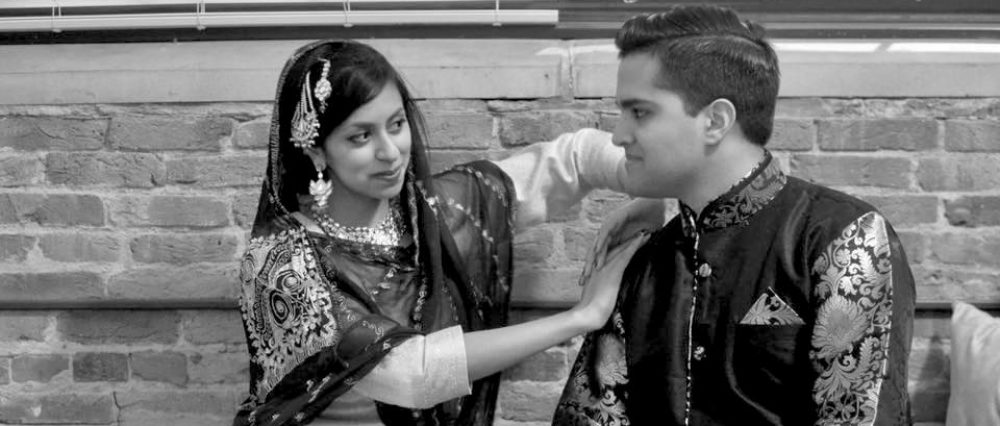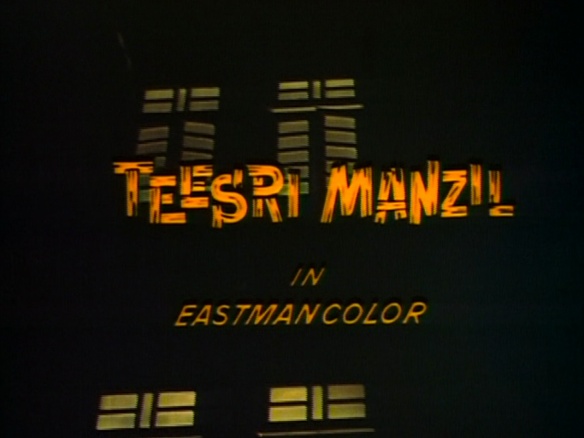No, really, what the heck is Eastmancolor? When you look closely at title screen of each of your favorite classic Bollywood films, you find the simple, but bold little phrase, “EASTMANCOLOR” conspicuously splashed across the screen. It’s gnawed quietly at the back of your mind for years. Is “Eastmancolor” part of the name of the film? Is someone making a not-so-clever reference to Indians themselves (“Who is this MAN from the EAST, anyway?”)!? But the words quickly dissolve, the film begins, and in the excitement and messiness of the resulting masala, why “Eastmancolor” deserves a holy spot right in the title screen remains forever an unsolved mystery. Luckily for you, that’s about to change.
Let’s back ourselves up and unravel this riddle from the start. When the first monopack colour film stocks hit Hollywood in the 1930s, India was eager to catch up and bring colour to Bollywood. But the process was not easy. Apart from being significantly more expensive than traditional black-and-white (silver halide photographic emulsion), coloured film stock brought with it a new set of artistic problems: development of the negative taking both luminosity and color into account.
The first colour film made entirely in India was Kisan Kanya (1937), produced by Ardeshir Irani who had also pioneered the first talkie of Hindi cinema 6 years earlier. However, poor box-office returns and difficulties and expenses in garnering rights to the American Cinecolor stock development process kept coloured film largely out of range for many years following. Guru Dutt, not surprisingly, was among the later auteurs who help revive its popularity. He experimented with the new colour cinematography in his timeless beauty “Chaudhvin Ka Chand”(1961) that highlights the effect of (fake) moonlight and colour ranges at night. The opportunity to use colour arrived mid-production, and although Dutt had wanted to reshoot the entire film with the new technology, budget and time-constraints forced him to film only this and one other song in colour before the release. Around the same time, K. Asif too experimented with the range of this new technology, incorporating the dazzling colour song “Pyar Kiya To Darna Kya” into his magnum opus Mughal-e-Azam (1961) as a stunning and vivid tribute to the full glamour of the Mughal Empire.
India’s full-length color feature, Mother India (1957), was a landmark film for many reasons, but notably for demonstrating that coloured film stock was the wave of the future—garnering a nomination for Best Foreign Film at the Academy Awards the year of its release. After the overwhelming success of Mother India, Bollywood began shifting its norm to predominantly coloured film, eventually using black-and-white sparingly for stylistic reasons (as in the film noirs or Teen Devian).
Prior to this era, colourizing film had been a technical and artistic nightmare—as far back as the 1910s and 1920s, filmmakers had been painting each frame of a film by hand, bleaching the film stock and adding color dye, or most popularly, using the expensive Technicolor multi-strip subtractive method. These options had little ground in the competitive, movie-a-minute atmosphere of India, and the hassle of processing such film stock (which often needed to be shipped abroad for the purpose), left India for many years colourless.
Eastmancolor, introduced in 1950 by Kodak was a novel and economic technology that used a single-strip 33mm negative-positive process incorporated into one strip of film. While a popular rival to expensive Technicolor, it unfortunately is also the stock most prone to fading over the years. The Eastmancolor emulsions are made of cyan, yellow, and magenta layers. The cyan is the first to fade—in films you see what were originally blue skies now turned white—then eventually all you have left are the sun-washed reddish hues. This gives us a classic image of badly preserved Bollywood films with faded colours and a warm tint. Contrast this with most beautifully vivid Technicolor processed films you can watch today (think MGM Judy Garland musicals), and you can see a big difference in how the colours have survived.
By the time DVDs rolled around, many of the films we know and love in Bollywood had suffered destruction in their original film stocks that no one bothered to repair before a DVD transfer. However, just to give you a hint of what we’ve lost, I’ve personally adjusted the color (albeit imperfectly), to a few stills below from some classic Bollywood films as they would have looked had they been printed on extremely saturated Technicolor. See how subtle thing like this can actually make a HUGE overall difference?! That faded look is merely a tragic artifact of time and neglect.
We often think that Eastmancolor was used only in Bollywood, but it truly started in America as a cheaper rival to Technicolor. In fact, with the advent of Cinemascope (a new widescreen format that once again changed the dynamic of filmmaking), Eastmancolor became THE industry standard—however, in America and unlike in India, the Eastmancolor stock was actually processed still by Technicolor using their sturdier dye-transfer printing. Therefore many films in America billed as “Technicolor” actually have an Eastmancolor base, but would retain their colour fidelity over the years. This is also true of the climax of Mughal-e-Azam which was also shot in and processed by Technicolor and has therefore remained brilliant over the years (helped, of course, also by the recent restoration project). The colours of that film look far different than the colours of classic Eastmancolor Bollywood films like Caravan (1978), Amar Akbar Anthony (1977), or Jewel Thief (1967). Sigh. A little investment would have gone a long way.

Madhubala glitters in K. Asif’s true Technicolor masterpiece Mughal-e-Azam (1961). Now THAT’s colour, people.
Satisfied? More information than you really wanted? I hope everyone’s burning curiosity has been slaked at last. The next time you and your hip friends watch an Eastmancolor film, you’ll be the cool cat who knows the full story. Impress the crowd with your knowledge, and poo-poo those provincial fools who think Eastmancolor simply meant Indian men making films! Fun fact: Eastman is actually the name of George Eastman who founded Kodak Photography in 1889!
This Bollywood Mystery request was submitted by faithful fan Pankaj. As always, shoot us an email and keep those requests coming!
-Mrs. 55















That was wonderful, and thanks for colorizing a few clips. It really showed the difference! The old movies have a certain charm in Eastman color since they are old and look old with their faded colors though.
Thank you! There is something to be said on charm factor of faded Eastmancolor prints–it’s like looking at a worn old family photograph 🙂 But at the end of the day, a vivid preservation is key to keeping alive the filmmaker’s original intentions and capturing the film’s true essence!
That was a really interesting post on a technical aspect of film making….the eastman colour thing was something at the back of my mind as well….I knew it was something to do with the colour technology being utilised but your post has provided some really interesting history. I think u’ve done a fabulous job with the colour adjustments u’ve made…looks pretty perfect to me.
Thank you! Eastmancolor is so ubiquitous in classic Hindi films, it’s easy to overlook–but for that sly name that always made me wonder if it was something else!
Thank you thank you thank you….for most of us growing up in India, this was the ultimate “black box” that has now been opened. BTW, I was one of those who did think that Eastman color originated in India, and the name reflected its origin- how wrong I was! But you still have not told us why it was called Eastman- was this the name of the person who invented the technology?
Glad you enjoyed! Oh, good point–I’ve made an update in the post. Eastman is the name of the founder of Kodak whose company developed Eastmancolor named in his honor!
Kudos on a very informative & enlightening post !
Couldn’t help but grin at your “unintended” pun on ‘East-man-color’ ;-))
Pingback: Ehsaan Tera Hoga Mujhpar Lyrics and Translation: Let’s Learn Urdu-Hindi « Mr. & Mrs. 55 – Classic Bollywood Revisited!
Interesting write-up with a hilarious start, and later starting to get pretty insightful.
But you’ve failed to mention one thing. That Eastmancolor (prior to fading) had a natural reddish hue, which suited certain movies; while Technicolor , was brighter with it’s blues and yellows.
For example a western like ‘The Searchers’ (1956) looked better in Eastmancolor, with it’s deserted landscapes et al. But a musical like ‘Wizard of Oz’ (1939), looked bright and colourful in Technicolor.
And speaking of hand painted plates, you can see some of them at the ‘Cinematheque Francaise’ museum in Paris. As true Film buffs, if you haven’t already been there, I’m sure you’ll love it when you do.
This was really interesting. 2 films you missed between Kisan Kanya and Mother India were Jhanak Jhanak Payal Baje and Jhansi ki Rani. The latter flopped by Jhanak Jhanak… was a blockbuster in 1955.
What was the color techniques used in early 1980’s . In 1980’s there was better picture quality something new , but looks like technicolor.
Pingback: Yeh Mera Prem Patra Lyrics and Translation: Let’s Learn Urdu-Hindi | Mr. & Mrs. 55 - Classic Bollywood Revisited!
In Latin America and Spain, Eastmancolor was used from the Late 1950’s through the early or mid 1980’s because the Technicolor was so expensive to bring in these countries so they conformed themselves with Eastmancolor especially in Argentine, Mexican and Spanish Cinema.
Kudos to you both for preserving such a rich heritage of India. These coloured images have made different feelings in the hearts of millions of Bollywood lovers!!! Keep it up!! At least there is some torch bearer in this area!!!!
My best wishes !! Ravinder!!